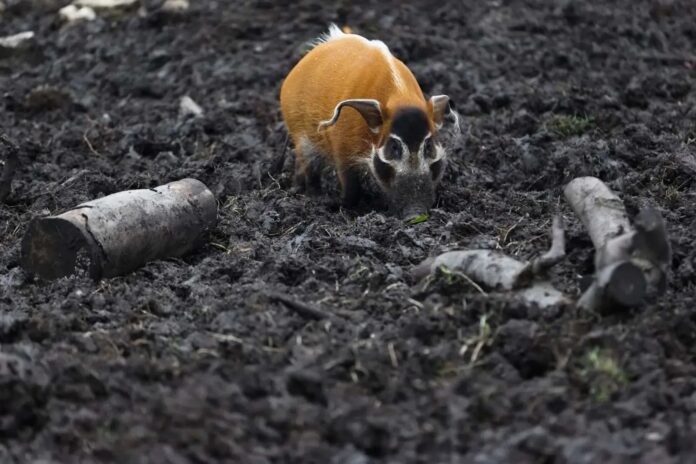While there are so many wild pig species around the world, not many people are aware of them. It is very easy to recognize wild pigs due to their large head, short neck, distinctive snout, and their temper. Many wild pig species are gifted with canine teeth that form prominent tasks that they use in fighting and rooting. They in groups called “sounders”, usually consist of adult male, several females, and their offspring. You will find 17 wild pigs below, let’s see how many of them that you know of.
1Banded Pig

Scientific Name: Sus Scrofa Vittatus
A banded pig has a short face, and it has a white band on its muzzle; hence the name. More than that, it also has a broad reddish band extending from the muzzle to the sides of the neck as well. The body of this wild pig has sparse body hair and no underwool; however, it has a fairly long mane. Males have long fangs that can grow up to 12 centimeters while females have shorter fangs. The males use these long, sharp, and strong fangs to ram the intruders when feeling threatened. As for the females with shorter fangs, they will lift and bite the intruders instead. Males of this species are polygynous and are attracted to estrous females, and they are very aggressive. They will chase females as a way to show attraction, and the females will respond by urinating if they are interested.
Native to many Indonesian islands and the Thai-Malay Peninsula, the banded pig also goes by the name Indonesian wild boar. These wild pigs usually live in agricultural areas or forests where they roam solitarily at night. Across their range, these frugivores feed on around 50 different fruits and their most favorites are figs. In areas where food is abundant, they also have more options. So they also feed on other things such as carrion, fruits, grasses, insects, roots, snakes, and tubers.
2Bushpig
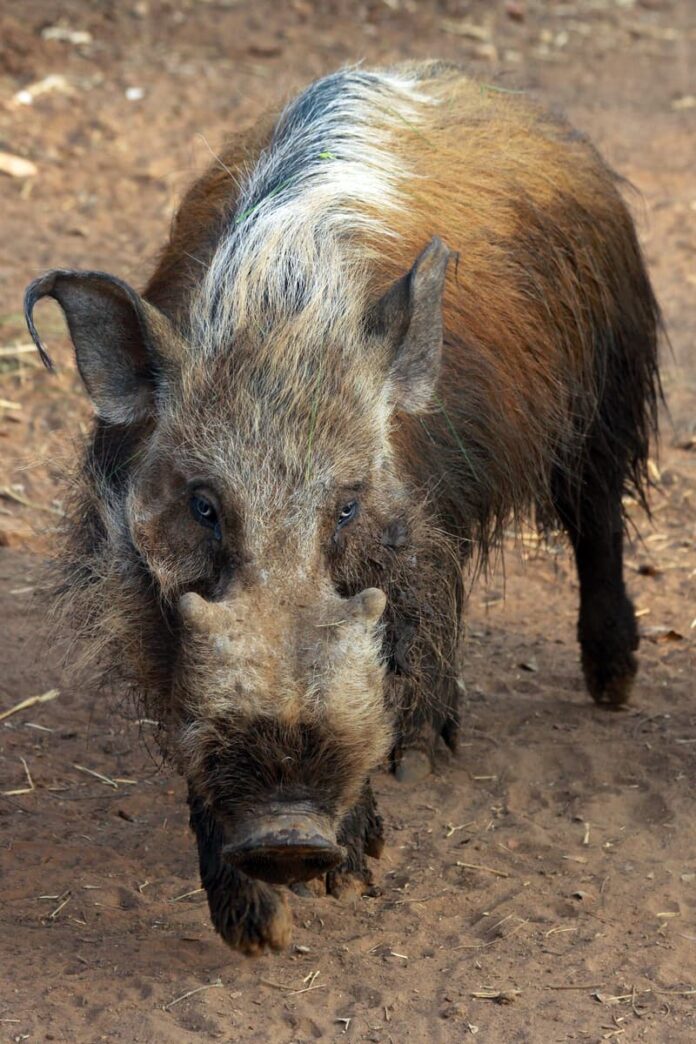
Scientific Name: Potamochoerus Larvatus
Oh, the beauty! Bushpigs look like a grown wise creature, and their elegance is beyond description. Adult bushpigs stand from around 66 to 100 centimeters tall at the shoulder, and their overall appearance resembles domestic pigs. One of their distinctive features is the “face mask” on their faces. This face mask contrasts the blackish-to-dark brown patterns and white-to-dark-gray markings. Males are usually larger than females, and both sexes have short and sharp tusks. A different range also means different hair colors and skin colors, and that’s the interesting part. The bushpigs in the southern area are dark reddish or even almost black. On top of that, the coat gets darker the older they get which is quite fascinating. You can tell an old male by the two warts on his snout, very obvious.
Bushpigs are common residents of cultivated areas, forests, riverine vegetation, and woodlands across East and Southern Africa. Some of their other habitats are flooded forests, forest fringes, forests with high trees, gallery forests, montane forests, thick bush veld, and swamplands. These omnivores feed on carrion, crops, eggs, fruits, insects, roots, rotten wood, small reptiles, succulent plants, and water sedges. As social animals, they live in a groups of up to 12 members but usually just 3 to 5. Each group has a dominant male and a dominant female, and two sounders can get aggressive when encountering each other. This can escalate into fights when food sources are involved though sounders usually keep away from each other. Bushpigs are dangerous to humans also as they are very aggressive, fast, and powerful, and they are good swimmers. It is always advisable to keep a good distance from them.
3Common Warthog
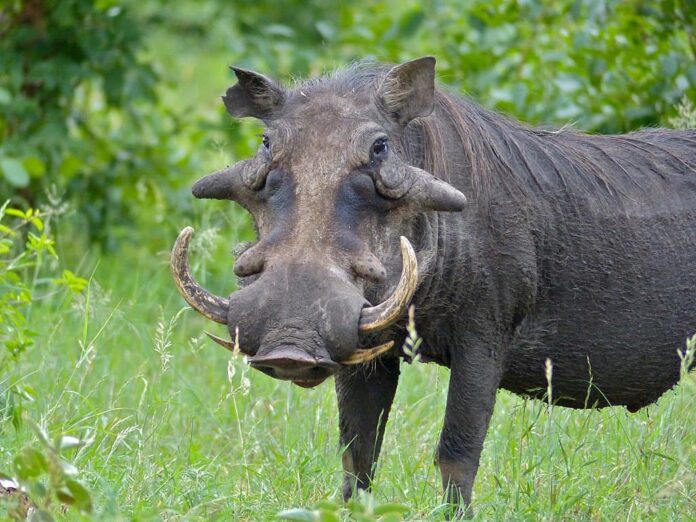
Scientific Name: Phacochoerus Africanus
This is one of the most common wild pig species, and probably the most popular one as well. A common warthog has a large head with a mane down the spine to the middle of the back. It has sparse hair that covers its sturdy body, and the overall color is usually black or brown. Their distinctive and signature feature is the two pairs of tusks protruding from the mouth and curving upwards. The lower pair is shorter but sharper as it rubs against the upper pair every time the pig opens and closes its mouth. These warthogs are powerful diggers, and they use both their snouts and feet to dig for borrows and food. And despite being able to fight, they usually flee by fast sprinting at speeds of up to 48km/h when threatened.
Common warthogs live in grassland, savannas, and woodlands in Sub-Saharan Africa. It is the only pig species that has adapted to grazing and savanna habitats, with an omnivorous diet. Their common meals are bark, berries, carrion, eggs, fruits, fungi, grasses, insects, and roots. They graze during the wet seasons and feed on bulbs, nutritious roots, and rhizomes during the dry seasons. They live in burrows where they reverse into so that they can burst out if necessary. Their common predators are cheetahs, crocodiles, hyenas, leopards, lions, wild dogs, and of course, humans. Birds of prey target the piglets but the mothers are not afraid to charge at larger predators to protect their young.
4Desert Warthog
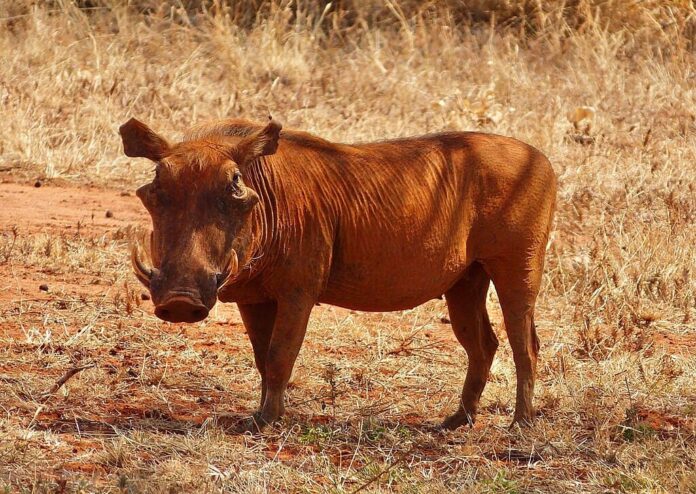
Scientific Name: Phacochoerus Aethiopicus
A desert warthog has a dark brown stocky body that is covered in bristly hairs. The hair is denser along the spine and forms a crest, making it look really nice. You can tell desert warthogs apart from common warthogs by the lack of functional incisors in desert warthogs. It has a flattened head and large curving canine teeth that protrude as tusks in adults. These tusks also allow them to create deep burrows but they usually steal them from other burrowing species.
Native to the Horn of Africa, desert warthogs inhabit open arid countryside such as thin woodland with scattered trees, sandy plains, and scrublands. As herbivores, these wild pigs forage for flowers, fruits, grasses, and leafy plants but they will also eat insects when food is scarce. They use their snout and tusks to dig up bulbs, tubers, and underground rhizomes. Females give birth in a burrow where they remain with newborns to nurse them for months. The young are not fully weaned until they are about 6 months old. Then, they will follow their mother wherever she goes, suckling every 40 minutes.
5Eurasian Wild Boar
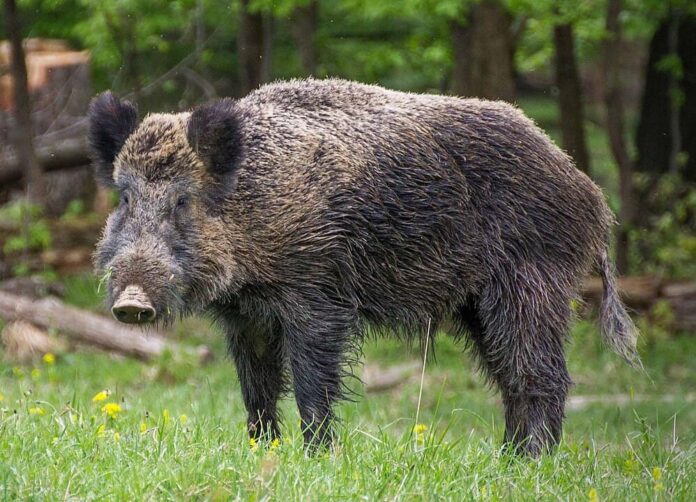
Scientific Name: Sus Scrofa
The Eurasian wild boars look a lot different from domestic farm pigs due to their hairy bodies and long straight narrow snouts. A Eurasian wild boar has a brown or dark black body with whitish hairs on their cheeks, face, and throat. Depending on their geographic locations, some also have a solid pelage or speckled color as well. Males are larger than females, and they are polygynous and solitary so they do not give any parental care. Meanwhile, females are social so they live in groups that are made up of several females and their offspring.
Despite the name, Eurasian wild boars are native to not only Eurasia but also North Africa. Having both a wide range and high numbers, this wild pig species also has the adaptability to various habitats. It is not uncommon to see them in arid environments, forests, and scrubs across Asia, North Africa, and Southern Europe. This ability also makes them an invasive species that damages crops and threatens native wildlife and domestic livestock. That is because they have reportedly preyed on small calves, lamb, and other livestock. Their common diet consists of crops, fruits, green plants, nuts, and roots as well as bird eggs, carrion, insects, and worms.
6Giant Forest Hog
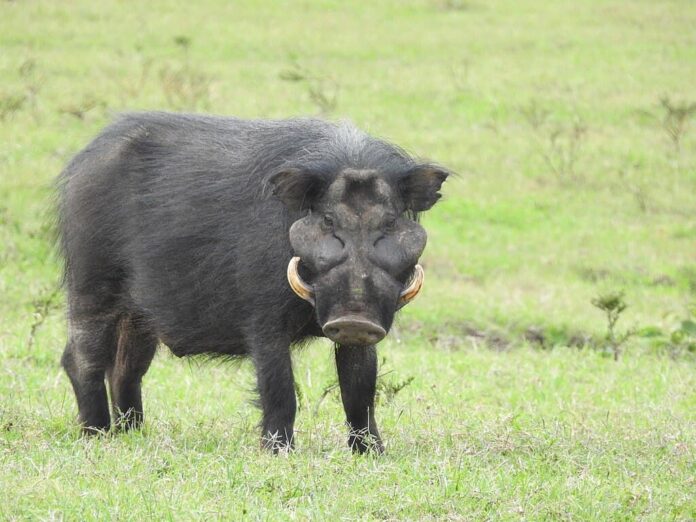
Scientific Name: Hylochoerus Meinertzhageni
Here you are looking at the largest wild pig species, measuring from 1.3 to 2.1 meters from head to body. It also has a long tail that is around 25 to 45 centimeters long as well. A giant forest hog is black in color on the surface, and it has extensive hairs on its body. Along with that, it also has a stocky build with a prominent hump on its back as well. While being quite large, their tusks are rather small than those of the warthogs but bigger than those of bushpigs. A male giant forest hog’s tusks are around 35.9 centimeters which is still pretty long. The tusks are large and curving, and they use these tusks for digging up roots and underground food.
On top of the fascinating size, giant forest hogs are also the only wild pig species that is native to wooden habitats in Africa. Their population is very common in forest-grassland mosaics but they also roam in subalpine habitats and wooded savannas as well. They prefer the dense shade of bushes and thickets so they inhabit dry forests, humid and lowland forests, and montane forests. A sounder of giant forest hogs consists of 6 to 14 individuals, led by a male. As both herbivores and scavengers, these wild pigs feed on carrion, eggs, grasses, herbage, roots, and sedges. In spite of being aggressive and territorial, these large forest hogs still fall prey to carnivores like hyenas, leopards, lions, and wild dogs.
7Hairy Babirusa
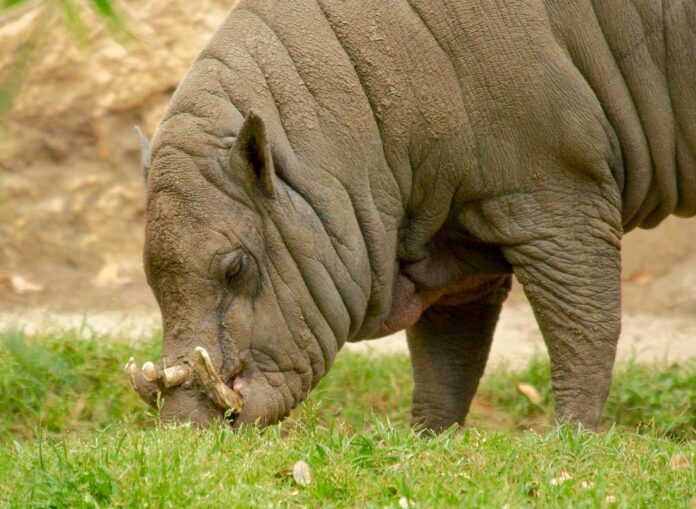
Scientific Name: Babyrousa Babyrussa
Babirusa is my personal favorite when it comes to wild pig species, the appearance and name say it all. This one is the hairy babirusa aka golden babirusa or Moluccan babirusa, and it is the most hairy among the subspecies. A hairy babirusa has long and thick gold-brown body hairs that are from 3 to 5 centimeters long. The hairs impart a yellowish tone across the body, and this feature does not exist in any other subspecies. Male hairy babirusas have 2 sets of tusks, and the upper pair grows into a curved shape. Along with that, they have powerful jaws and teeth that are strong enough to crack all kinds of nuts. The males actively hone their tusks on trees, and they clatter their teeth when excited.
As wild pigs, they inhabit tropical rainforests and areas with river banks or other natural ponds that are rich in water plants. These omnivores feed on fruits, leaves, invertebrates, and small vertebrates, but their favorite meals are roots in soft muddy, or sandy soils. One weird thing about them is that cannibalism is a thing among babirusas, feeding on the young of their own species. Their population is considered Vulnerable on the IUCN Red List due to habitat loss and hunting. The indigenous people of Buru and the locals hunt hairy babirusas for meat due to their flavor and texture.
8Javan Warty Pig
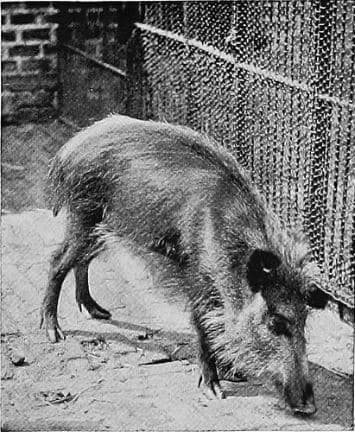
Scientific Name: Sus Verrucosus
The Javan warty pig aka Javan wild pig is black in color, with some rufous parts on its head and belly. A Javan warty pig has a dorsal and nuchal crest that stands erect when it is startled. At the same time, the tail will erect and curve towards its body when it is fleeing from a predator. The hair of the Javan wild pig is usually reddish in color. Males are larger than females, and they are around twice as heavy. Not different from other omnivorous wild pigs on the list, they also feed on grains, leaves, nuts, roots, seeds, small mammals, and tubers. This one is endemic to the Indonesia Islands including Bawean and Java, and they are listed as Endangered. Its main threat is habitat encroachment by humans for agricultural and human civilization purposes.
9Mindoro Warty Pig
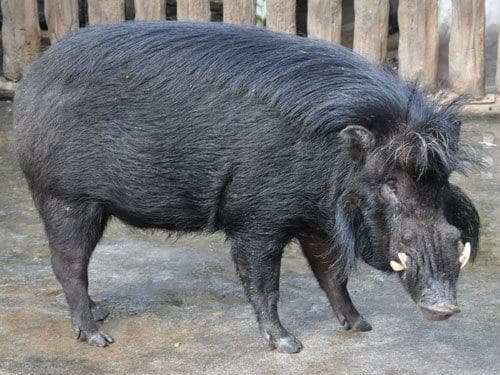
Scientific Name: Sus Oliveri
Also goes by Oliver’s warty pig, the Mindoro warty pig is black or dark brown in color with a mane of elongated hair. This mane extends from the top of the head to at least the shoulders. Native to the Central Philippines, you can only find them on Mindoro Island. While the actual habitats are unclear, some of them are seen in dry-molave, lowland, and mid-montane forests as well as savannah grasslands. In those areas, they feed on fallen fruits, invertebrates, tubers, and a wide variety of plants. Their conservation status has been Vulnerable since 2016 due to habitat loss, hybridization with domestic swine, and overhunting.
10Palawan Bearded Pig
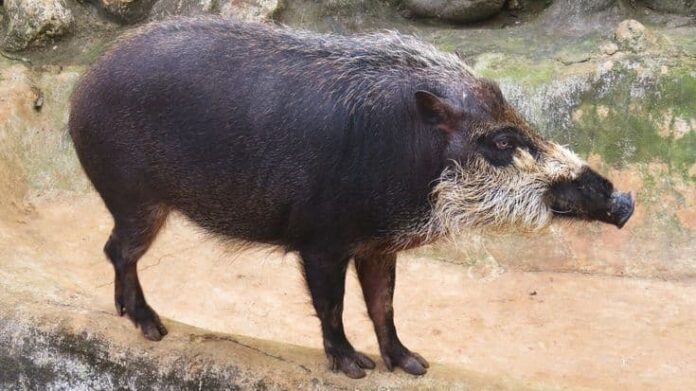
Scientific Name: Sus Ahoenobarbus
Allow me to introduce you to the largest wild pig species in the Philippines, with a head-and-body length of 142 to 154 centimeters. The body of a Palawan bearded pig is dark gray to black, and there is sparse black hair covering its neck, trunk, and limbs. Adults have a distinct mane of longer whitish hairs extending from crown to rump, and long white hairs on the cheeks and jowls. Endemic to the Philippines, the Palawan bearded pigs are residents of the archipelago of Balabac, Palawan, and the Calamian Islands. They inhabit forests, grasslands, and wetlands where they feed on crops, fallen fruits, and invertebrates and vertebrates like arthropods and earthworms. The Palawan bearded pigs have been considered as Near Threatened on the IUCN Red List in 2017. Their main threats include habitat destruction due to agriculture, logging, and urban development, and hunting.
11Philippine Warty Pig

Scientific Name: Sus Philippensis
Here is one of the four wild pig species endemic to the Philippines, the Philippine warty pig. A Philippine warty pig has a dark body covered by dark fur, and it has tufts of hair on its head and jaws. The tufts on a female’s head are called crowns while the ones on the male’s head are called manes. Males are larger than females, and they have larger tusks as well. Their canines curve upwards, and they have two pairs of warts on their faces. Unfortunately, this wild pig is considered Vulnerable with a declining population due to multiple threats. Some of the main threats are African swine fever, habitat disruption, habitat loss, heavy hunting, and severe fragmentation.
12Pygmy Hog
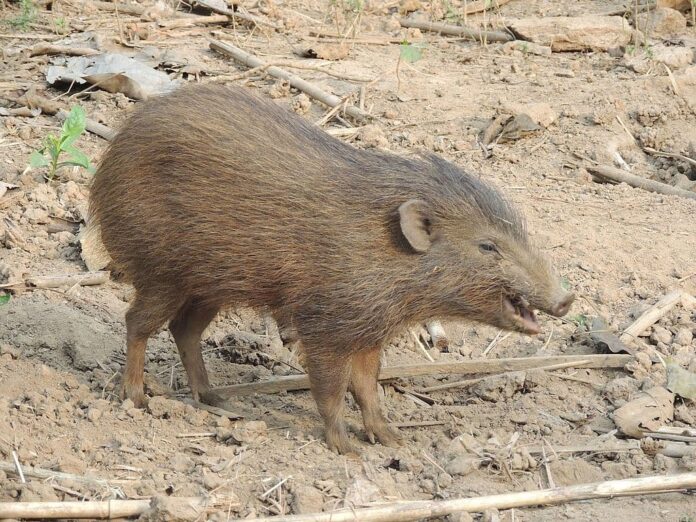
Scientific Name: Porcula Salvania
The name says it all, a pygmy hog is a small pig species that is quite cute. Growing to just 20 to 25 centimeters tall and 55 to 71 centimeters long, it is the world’s smallest wild pig species. It is grayish-brown in color, and it has blackish-brown bristles on its coat. The most distinctive feature of the pygmy hogs is their sharply tapered head with a slight crest of hair on their forehead. Adult males have upper canines that are visible on the sides of their mouths, and they have no facial warts.
Pygmy hogs are endemic to India, native to the grasslands in the foothills of the Himalayas. These omnivores eat fruits, grasses, leaves, roots, and seeds, along with invertebrates. While most wild pigs out there stay in burrows, this one is rather different. Pygmy hogs dig small trenches in tall grasses, and they use dry grasses and vegetation to line those trenches. The trenches are where they sleep during the night, retreat to during the day, and warm up in the winter. They also use this nest for birthing and hiding their newborns. Their population is very small due to human encroachment and natural habitat destruction along with fires, livestock grazing, and poaching. With just around 200 individuals, pygmy hogs are now endangered.
13Red River Hog
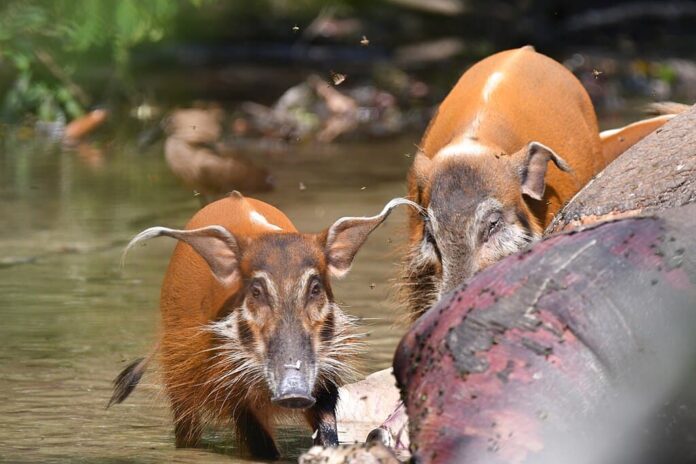
Scientific Name: Potamochoerus Porcus
Isn’t this a cute little thing? A red river hog has an eye-catching orange to reddish-brown fur with a white stripe along its spine. The most attractive feature of this wild pig species is probably the white tufts on their cute ears. There is also fur on the jaw and flanks of the hog, making this fuzzy little ball look absolutely adorable. Just like other wild pig species out there, the males are larger thanthe females. They live in a sounder of 6 to 10 animals, led by a single adult male. A male and female pair for life, and the rest of the members are usually their offspring. This boar defends his young very aggressively, especially against predators.
Red river hogs are one of the wild pig species in Africa, inhabiting rainforests and areas near rivers or swamps. You can also find them in forested valleys, marshes, and wet dense savannas. These areas are rich in their common meals such as bulbs, fruits, nuts, roots, seeds, tubers, and water plants. Since they don’t have canines or tusks like their cousins, they dig up roots and insects using their snouts. Along with that, they also feed on dead animals, eggs, insects, lizards, reptiles, snakes, and even goats, piglets, and sheep. They are also fast runners and great swimmers, and they can swim underwater; catching a breath every 15 seconds. Red river hogs are an adaptable species, and human encroachment does not affect them as it affects other species.
14Sulawesi Babirusa
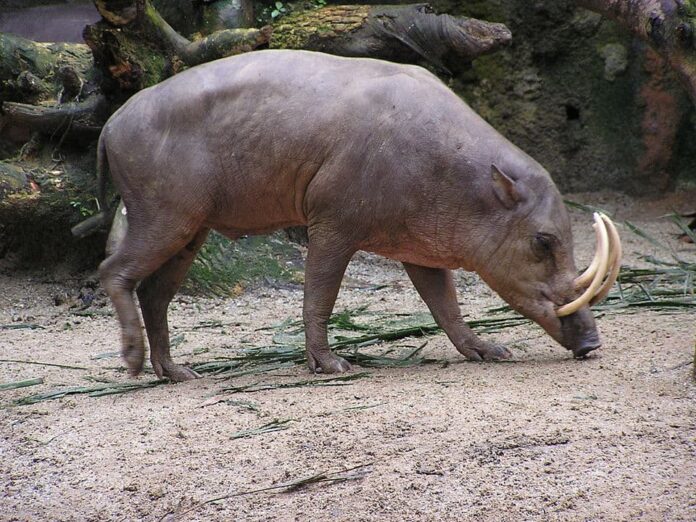
Scientific Name: Babyrousa Celebensis
A Sulawesi babirusa has a barrel-shaped body and long face, and its wrinkled skin is gray overall. Unlike the hairy babirusa, the Sulawesi babirusa is virtually hairless, and its tail-tuft is also nearly hairless. Males have an intimidating look from the 2 pairs of large tusks, and the upper pair penetrates the animal’s skull. The older it gets, the longer the upper tusks grow, curving back toward its forehead, killing it slowly. As for the lower canines, they emerge through the side of the mouth. Females have way shorter canines but the upper tusks in some individuals also erupt through the skin of their rostrum.
The Sulawesi babirusa or North Sulawesi babirusa is a wild pig species native to Sulawesi Island of Indonesia. They inhabit the shores of lakes and rivers, and the underbrush of canebrakes and tropical forests. Where they live, they feed on fallen fruits, fungi, grasses, herbs, leaves, invertebrates, roots, and small vertebrates. Males are solitary but they do form small bachelor herds of 2 to 3 members sometimes. The females usually live in groups of up to 8 individuals along with their young. This babirusa species is threatened by deforestation and illegal hunting.
15Sulawesi Warty Pig
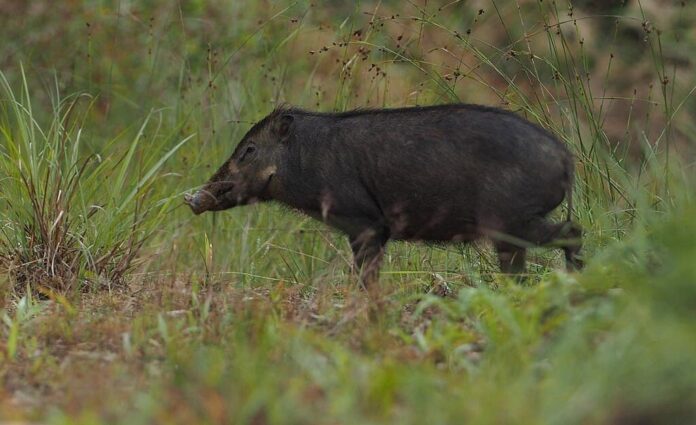
Scientific Name: Sus Celebensis
More commonly known as the Celebes warty pig, the Sulawesi warty pig is the only wild pig species that has been domesticated. Its head-and-body length is around 80 to 130 centimeters long, and it has a long tail. Males are larger than females but both sexes have short legs and a rounded back. The color of this pig is usually grayish-black with a red or yellow tinge on the flanks sometimes. On the crown and nape of the pig is a short crest of thick black bristles that extends into a dark dorsal stripe.
Just like the name suggests, the Sulawesi warty pig lives on Sulawesi Island in Indonesia. They inhabit various areas such as agricultural areas, cultivated land, high grassland terrains, rainforests, and swamps. These warty pigs usually feed on carrion, fallen fruits, invertebrates, leaves, roots, shoots, and small vertebrates. Their population has been threatened by various threats including habitat destruction and fragmentation, hunting for meat, and hybridization with domestic pigs. However, they are still very widespread across their ranges.
16Sunda Bearded Pig
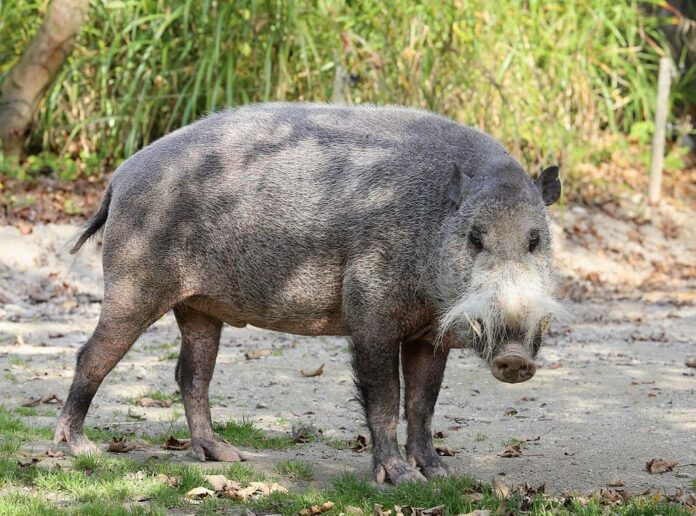
Scientific Name: Sus Barbatus
The Sunda bearded pig aka Bornean bearded pig or just bearded pig has a very eye-catching appearance. You can easily recognize one by its prominent beard that is up to 15 centimeters long; hence the name. The beard has coarse bushy hairs on the bridge of their cheeks and nose, and it is more pronounced in males. Bearded pigs are large and long-legged, and they have a sparsely-haired body that is generally pale gray. However, the color can vary from dark brown, reddish-brown, or very pale depending on their locations. Fun fact, bearded pig has the slimmest torso and the longest head among all living pigs.
This wild pig species is found in Southeast Asia including Indonesia and the Malay Peninsula. Across their range, they inhabit mangrove forests and rainforests where they feed on carrion, fruits, fungi, invertebrates, roots, and plants. The most fascinating thing about them is that they live in one location in a stable family group. And several hundreds of them will join together for the annual migration led by old boars. They travel during the night and retreat to the thickets during the day, and they take the same route every year. Bearded pigs are extinct in Singapore and the Philippines, and they are vulnerable in Brunei, Indonesia, and Malaysia. The main threats to their numbers are deforestation of palm oil and rubber plantations, and human persecution.
17Visayan Warty Pig
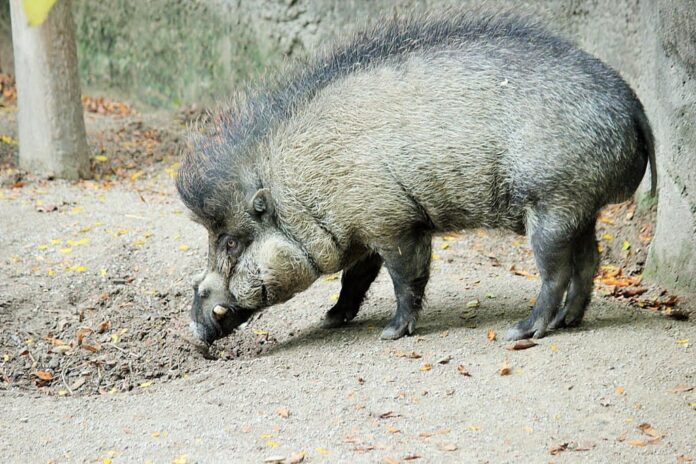
Scientific Name: Sus Cebifrons
Have you ever seen a pig with a mohawk? This is one, and that stiff spiky hair is everything. During the breeding season, the males grow a coarse and floppy mane at a length of 22 centimeters. And, of course, the females love this. On top of that, the males also grow 3 pairs of fleshy warts on their visage. Plus the large tusks for sparring to get females, they are absolutely one of a kind. As for the overall appearance, a Visayan warty pig is dark gray and the rest of the body is covered with bristly hairs. These bristly hairs are light brown or silver in males, and they are dark in females. The coolest part? They can raise the hairs on their backs to appear larger!
This wild pig species got its name from its origin as it is endemic to 6 of the Visayan Islands. You can find them on Cebu, Guimaras, Masbate, Negros, Panay, and Siquijor, and these islands are in the central Philippines. These rock stars inhabit dense and tropical rainforests where their favorite food is abundant. They have an excellent sense of smell which helps them locate food, even the underground ones. Where they live, they mainly feed on fruits, roots, and tubers in the forests. However, local farmers cut down the forests which are their natural habitat to plant crops. Therefore, their population is declining and they are considered critically endangered due to habitat loss, hunting, and population fragmentation. In fact, it is believed that they are already extinct in one of the 4 islands among those 6.
Related Post: Wild Goat Species Around The World

